HSpot is a tool conceived for guiding the users in planning and submitting observations with the Herschel Space Observatory.
It is based on Spot (Spitzer Observing Planning Tool) developed for NASA's Spitzer Space Telescope and it includes many upgrades designed for the formulation of observing requests for the three science instruments on board Herschel (HIFI, SPIRE and PACS).
The HSpot software is available, for several platforms, from the public pages of the Herschel Science Center (HSC) web site (HSpot download).
The HSPOT Manual provides a very detail description to guide the observer in planning and submitting a proposal.
|
How Planning an observation.
The instruments on board the Herschel Observatory allow to perfor a wide range of scientific observations (photometric and spectroscopic) by using several Observing Modes.
The process for planning an observation with Heraschel consists in joining the desired target with an Observing Mode, using an Astronomical Observation Template (AOT). An AOT contains all the instrument paramenters that completely specify the observation.
For every Herschel instrument, several AOTs are available. The instrument setting, together with the target information, compose an Astronomical Observation Request (AOR), which is the primary unit of Herschel observing time.
|
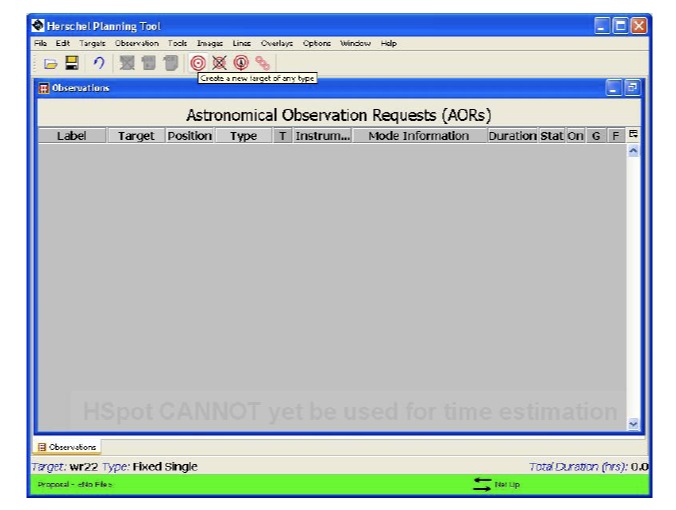
The HSPOT Main Screen.
Main steps to prepare an AOR.
An internet connection to contact the Herschel Science Center (HSC) is required to execute several steps in the preparation of proposals.
The HSpot main screen contains the icons and the menu associated with all the HSpot functions. A tool tip
is displayed by placing the cursor over the icon; a sentence message helps to understand the functioning of the icons and, where it's necessary, provide data entry instruction.
You can access to the target entry dialogue by clicking the bull-eye icon  on the HSpot main screen. The target name can be resolved by consulting the SIMBAD Astronomical Database or the NASA/IPAC Extragalactic Database. If the target is found in the database, HSpot automatically enters the coordinates, otherwise the right ascension (RA) and declination (Dec) must be put manually in. on the HSpot main screen. The target name can be resolved by consulting the SIMBAD Astronomical Database or the NASA/IPAC Extragalactic Database. If the target is found in the database, HSpot automatically enters the coordinates, otherwise the right ascension (RA) and declination (Dec) must be put manually in.
Every new target is updated on a List of Target, which can be consulted and edited by clicking on the icon  . .
The following tools can be directly reached from the target entry window:
- Sky Background Estimator
- Visibility Windows
|
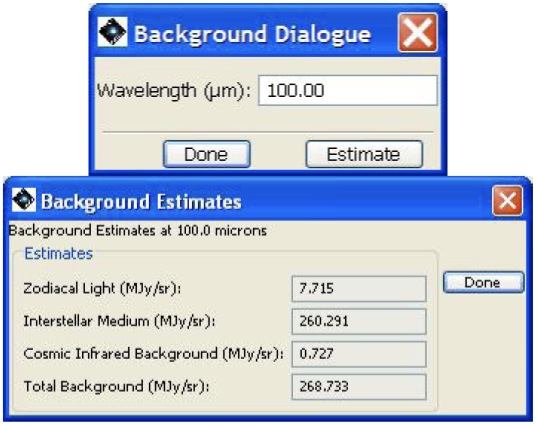
(top) The background dialogue where you must enter the desired wavelength.
(bottom) The results for several components of the background for the selected target.
Several components contribute to the emission of infrared background (for a brief description click here). Indeed, an important ingredient required for planning an Herschel observing program is to have knowledge of the absolute brightness of the sky at the observation time. To judge the feasibility detection of astronomical sources in the presence of strong foreground signals, the observer requires the knowledge of the background sky level relative to the astronomical source of interest.
HSpot provides tools for estimating the sky background.
It should be taken into account that HSpot does not "remember" the sky background levels when creating AORs, but the observer must consider the estimated background emission when preparing observations.
The background estimator is reachable by clicking the "Background" button on the HSpot target entry dialogue. Thus the observer enters the desired wavelength.
A target Visibility dialogue appears and the observer can specify the visibility window in which HSpot estimates the background emission
The provided values are in MJy/sr. The 'beam size' of the interstellar medium component of HSpot's background model is 5 arcminutes.
Back to top
|
The reference Instrument Manual are the primary documents for having information about instrument observing modes (HIFI, SPIRE and PACS) and selecting the appropiate AOT.
The AOTs are accessible from the "Observation" menu on the HSpot main screen.
Here the main topics ("Observations") for every instrument are summarized and the root for the Astronomical Observation Request (AOR) label is specified:
- HIFI AOTs:
- Single Point ("HPoint")
- Mapping ("HMap")
- Spectral Scan ("HScan")
- PACS AOTs:
- Photometer ("PPhoto")
- Line Spectroscopy ("PSpecL")
- Range Spectroscopy ("PSpecR")
- SPIRE AOTs:
- Photometer ("SPhoto")
- Spectometer ("SSpec")
- SPIRE PACS Parallel Mode ("SPParallel")
When an "Observation" is selected, the AOR dialogue appears and the desired AOT can be fully identified by setting the Observing Mode properties.
The selected AOT, together with the instrument settings and the target specification, compose the AOR. The AOR label is set by default with a prograssive number on the "Oservation" root (e.g. Pphot-001), but it can be edited by the user.
Once the AOR is defined and accepted ("Ok" botton), it appears on the HSpot main screen and it can be edited with a mouse double-click.
|
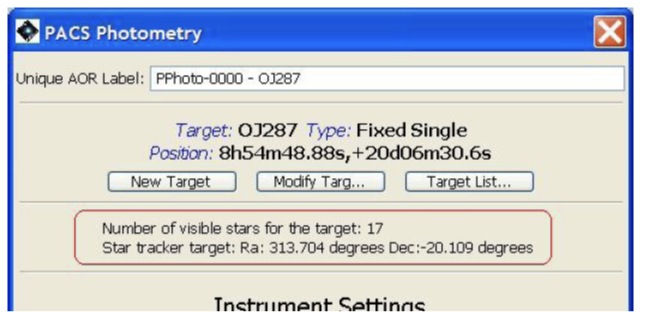
The startracker informations are shown in the red box.
In the AOR dialogue window, Startracker information are provided (in figure it has been circled with a line). The star tracker looks in the opposite direction
to the telescope in the sky and is used for acquisition and guiding. Pointing may be slightly worse in the cases where the number of stars, available to the
startracker for the target, drops below 9. If this number is smaller still there may be some difficulty with carrying out the requested observation.
|
In the observing modes where a chopping/nodding pattern is expected, it might be necessary to exclude some position angles of the chopping direction (chopper avoidance angle) to avoid chopping into bright nearby infrared sources.
The chopper avoidance angle effectively defines an avoidance angle for the satellite orientation (Position Angle), fixing a strong timing constraint on the observations.
For sources in the ecliptic the Position Angle (PA) will barely vary with time during a visibility window. In these case, the definition of a avoidance angle is, at best, irrilevant (as the PA will only vary in a range of a few degrees anyway) and, at worst, catastrophic, because makes the observation totally impossible, with no part of the visibility window permitted.
At high ecliptic latitude (> 60 degrees) we have a zone of permanent sky visibility and the PA rotates rapidly with time. So, selecting a chopper angle
may equate to only a relatively small effective restriction on dates.
At intermediate ecliptic latitudes the chopper PA will often rotate through 360 degrees giving a dephase that must be taken into account when
defining a chopper avoidance angle.
The chopper avoidance angles can be specified in the Observing Mode settings. If chopper avoidance angles are set, the visibility windows are biased by this selection.
|
The necessary ammount of time for performing an observation is computed by clicking on the "Observation Estimation" button at the bottom of AOR dialogue window.
HSpot returns a new dialogue window which reports the Instrument Performances summary, including the time estimation and the noise estimation (see the section).
The time that Herschel will require to execute the AOR is reported as "Total time" which is the sum of on-source integration time and overheads (instrumental and observatory overheads).
You need to request this ammount of time in your observing proposal.
The field returned by the time estimator include some auxiliary information which depend both on instrument and observing mode selected.
The duration of the AORs must be updated every time that the AORs are revised, before the proposal submission.
Back to top
|
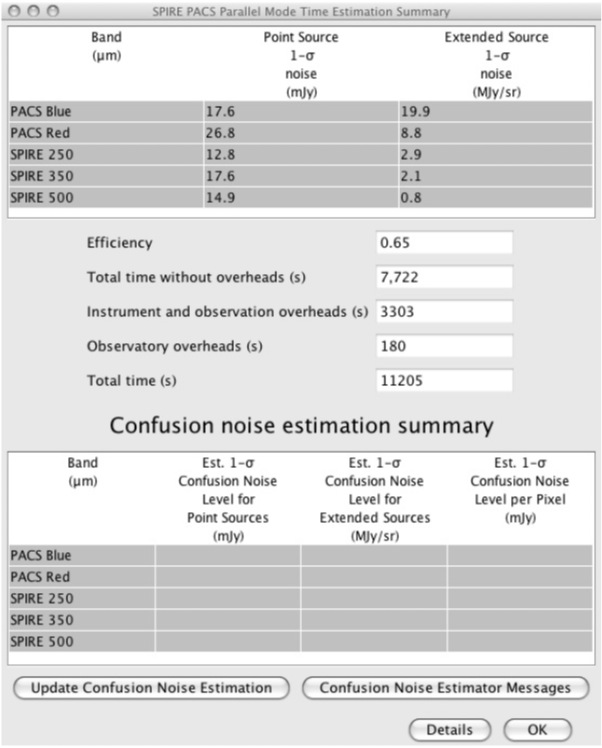
The window of instrument (PACS/SPIRE parallel mode) time estimation summary.
In order to get a confusion noise estimation the
"Update confusion noise estimates" button has to be pushed.
The noise estimation is a critical aspect for planning an observation. Two kind of noise contribute to the final sensitivity: the instrumental noise and the confusion noise (for details click here).
The estimation of noises is accesible in HSpot by fixing an AOT (see the section) and clicking on the "Observation Estimation" button. A new dialogue window reports the time estimation (see the section) and on the top the instrumental noise and on the bottom the confusion noise.
Noise values are affected by both instrumental and observing mode settings and in particular, whilst the instrumental noise only alters with the variation of integration time, the confusion noise also is affected by the observed target position. It means that
the same observational settings can have different confusion noise values for different targets.
In Herschel Confusion Noise Estimator the noise values regarding to the different components of infrared background are stored with respect to a given 'reference' configuration only.
The released confusion noise values are calculated using the reference values and extrapolating the coefficients related to the desided configuration (for more information about the Herschel Confusion Noise Estimator, see the manual).
When the HSPOT "Observation Estimation" window pops up, the confusion noise table is empty. For getting a noise estimation, the "Update confusion noise estimates" button has to be clicked. If the estimated confusion noise is higher than the instrument sensitivity, HSpot provides a warning message. You may consider to reduce the integration time unless there is a well established reason to observe deeper than the local confusion noise limit.
Back to top
|
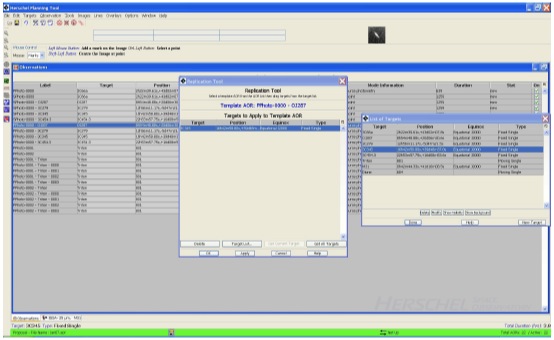
An example of replicating an AOR. A PACS photometry AOR has been selected,
highlighting it in blue in the observations table. Target 3C345 is then
selected from the Target
List and dragged and dropped into the
Replication Tool window.
In order to use the same observing setup, the user is supplied with replication capabilities that allow the same AOR to be applied to a number of targets. The AOR Replication Tool allows HSpot to create a number of AORs automatically by merging a 'template' AOR and a list of targets. For every target in your selected group, an AOR will be created with the template parameters. To use the AOR Replication Tool:
- create the 'template' AOR and select this AOR on the HSpot main screen;
- select the "AOR Replication Tool" from the Tools menu;
- select the targets you wish to have merged with this template:
- opening the current Target List and then drag-and-drop targets from the target list into the "AOR Replication Tool" window;
- selecting the highlighted target in the Target List with the "Get Current" button from the "AOR Replication Tool" window or selecting all of the targets in the Target List with the "Get All Targets" button (this replicates the AOR for ALL targets, including the target that was used for the AOR selection).
- clicking "Apply" or "OK", the new AORs will be created. "Apply" leaves the dialogue window open so that you can continue editing and do more replications. "OK" creates the AORs
and closes the dialogue.
You can use the Target Replication Tool, in an analogous way to the AOR Replication Tool, to create a number of AORs automatically by merging a set of AORs with a list of targets. It creates an AOR, with the selected target, for each AOR in the set. In other words, if you want to apply a set of 5 AORs to each source of a target list of 20 objects, you can do that using this tool.
Back to top
|
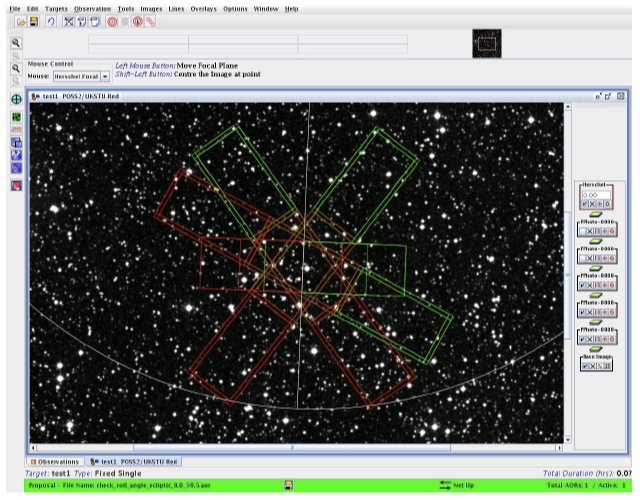
PA variation for PACS for an object at an ecliptic latitude of 59.5 degrees.
The horizontal position is PA=0 degrees, while the other plotted position of
the PACS imaging detectors correspond to PA values of 127.4, 54.6, 333.7 degrees.
Very useful functions for planning an observation are the HSpot visualition tools.
Images of a variety of different wavelenghts of the target region can be downloaded and displayed within HSpot. Using the "Images" menu on the HSpot main screen, images from the following image catalogues can be loaded:
- ISSA/IRIS image
- 2MASS
- MSX
- DSS
- multiwavelenghts SkyViews
- NED image
- ISO archive image
- NVO image
- All Sky images (DIRBE and ISSA)
HSpot can also display FITS files stored on the PC or reachable specifyinf a URL.
Several options for overlaying information on loaded images are available using the "Overlay" menu. Here can be overlaid catalogues, coordinate grid, Herschel focal plane, target position and AORs.
|
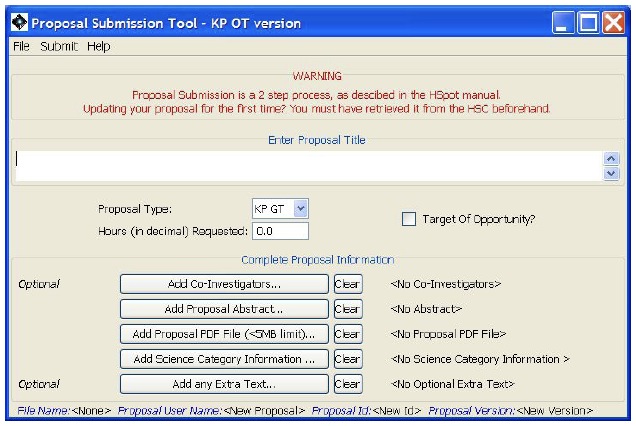
The "Proposal Submission Tool" main screen.
When a proposal is ready to be submited to the Herschel Science Center, the set of AORs concerning the proposal must be loaded into the AOR window and the Proposal Submission Tool ca be open. Within the "Proposal Submission Tool" main windows it is possible to:
- enter the full proposal title;
- select the proposal type (for example GT or OP project);
- select the hours of observatory time requested;
- indicate if the proposal contains targets of opportunity;
- add Co-Investigators;
- add Proposal Abstract;
- add Proposal pdf file;
- add Science Category Information;
- add any Extra Text.
In order to submit ("Submit" menu) a proposal as a PI, you must be registered to the Herschel Science Center and you need to ensure internet connection.
The proposal already submitted can be update using the "Update proposal at HSC" option in the "Submit " menu.
Back to top
|
|

